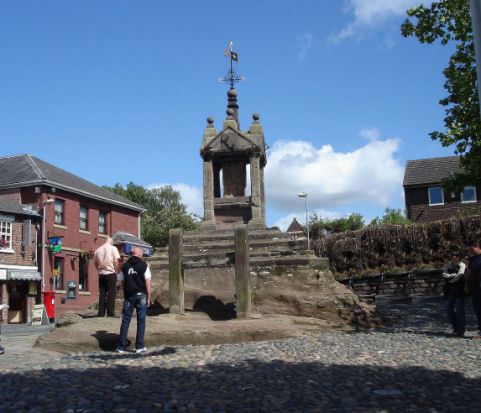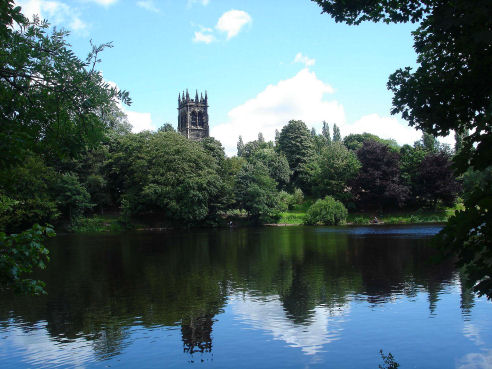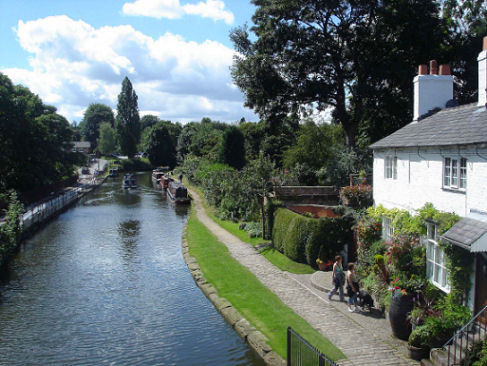Lymm
OS Grid ref:- SJ685875
Lymm village centre, situated near to the town of Warrington, is a designated conservation area which is particularly notable for its historic buildings. These include the terracotta former Lymm Town Hall, built in the French style, St Peter's Church, Oughtrington Hall and Lodge, now Lymm High School and Lymm Hall. The name is of Celtic origin and means "place of running water".
Lymm Cross

St Mary's Church, which dates to 1850-52, is set in a pleasant location overlooking tree lined Lymm Dam. A church has occupied the site since the 11th century. The chancel has a panelled ceiling, the pulpit dates back to 1623. The font is octagonal and probably dates probably from the 1660s. The church contains an ogee-headed tomb recess dating from about 1322 that has been moved from an earlier church. It contains a reputed Roman altar.
Lymm Village Cross, known simply as "The Cross", is a Grade I listed structure. The red sandstone cross dates from the early to the middle seventeenth century and was restored in 1897. It stands on an artificially stepped natural outcrop of red sandstone. Its shaft stands in a square pavilion of red sandstone with square corner pillars. The cross has been provided with a stone roof with a pedimented gable to each face . Above the cross is an extension which is decorated and an ornate weather vane. On the east, south and west gables are bronze sundials of 1897 carrying the inscriptions "We are a Shadow", "Save Time" and "Think of the Last".
Lymm Dam
Lymm Dam was created in 1824 by a dam built during the construction of what is now the A56 road. A local beauty spot, the dam has received the coveted Green Flag award, the benchmark of excellence for recreational park areas. The 17-hectare site includes woodlands, meadows and water bodies and is teeming with wildlife.

A path circles the dam, much of which is enclosed by woodland, the canopy species being mainly oak, beech, ash and sycamore. The tall Lombardy poplars along the eastern and western edges of the site are a legacy of Lord Leverhulme's planned housing scheme. Lymm Dam's variety of habitats means that there is an impressive array of bird species. Nuthatch, treecreeper and lesser spotted woodpecker can be seen in woodland areas, whilst herons are a common sight fishing in the shallow waters of the Upper Dam. Kingfishers nest in the banks over the Main Dam.
Sandstone Lymm Hall dates back to the seventeenth century although it was much altered and extended in the nineteenth Century. The hall was home to the Domville family for over three and a half centuries. The hall's rose garden was designed by Edward Kemp in 1849 and was his first recorded commission. The moat is now dry and probably dates to the middle of the seventeenth century. The Hall has been in the ownership of the Cotterill family since the early 1900's.
The Bridgewater Canal runs through the village, opened on 17th July 1761 and constructed to transport the Duke of Bridgewater's coal from his mine at Worsley, the canal has a special place in history as the first canal in Britain to be built without following an existing watercourse. The Bridgewater Canal is connected to the Manchester Ship Canal via a lock at Cornbrook, the Rochdale Canal in Manchester, the Trent and Mersey Canal at Preston Brook, southeast of Runcorn, and to the Leeds and Liverpool Canal at Leigh.
The Bridgewater Canal at Lymm

Lymm Heritage Trail which is 3.5 miles long is a self-guided trail exploring the built and natural heritage of the village. The route is based on the north/south valley which runs through the village centre (comprising Lymm Dam, the Dingle and Slitten Gorge) and two east/west routes - the Bridgewater Canal and the Trans Pennine Trail. The route is way marked and route maps can be found on each of the eleven information boards along the trail.
Nearby places of interest
Walton Hall Gardens, situated to the south west of Warrington, was originally part of a much larger country estate, purchased in 1812 by the famous Greenall brewing family.
